A Two-Stage Multistep-Ahead Electricity Load Forecasting Scheme Based on LightGBM and Attention-BiLSTM
Abstract
:1. Introduction
- We present a forecasting model that combines an ensemble learning method and an RNN for accurate MSA forecasting;
- We show that the performance of an MSA forecasting model can be further improved by considering the prediction result of a single-output forecasting model;
- The proposed model shows very stable forecasting accuracy over the entire forecasting horizon of 96 time points at 15 min intervals.
2. Related Works
3. Data Collection and Preprocessing
3.1. Weather Data
3.2. Calendar Information and Historical Electricity Load
4. Methodology
4.1. Single-Output Forecasting
4.1.1. LightGBM
4.1.2. Time Series Cross-Validation
4.2. Attention-BiLSTM Based MSA Forecasting
4.2.1. Bidirectional Long Short-Term Memory
4.2.2. Sequence-to-Sequence Recurrent Neural Networks
4.2.3. Attention Mechanism
5. Results and Discussion
5.1. Single-Output Forecasting Results
5.2. Multistep-Ahead Forecasting Results
6. Conclusions
Author Contributions
Funding
Institutional Review Board Statement
Informed Consent Statement
Data Availability Statement
Conflicts of Interest
Abbreviations
| ICT | information and communications technology |
| STLF | Short-term load forecasting |
| AI | artificial intelligence |
| MSA | multistep-ahead |
| RNN | recurrent neural network |
| LSTM | long short-term memory |
| GRU | gated recurrent unit |
| S2S | sequence-to-sequence |
| ANN | artificial neural network |
| ARIMA | autoregressive integrated moving average |
| MLR | multiple linear regression |
| PCR | principal component regression |
| PCC | Pearson correlation coefficient |
| WCI | windchill index |
| GBM | gradient boosting machine |
| ReLU | rectified linear unit |
| MAE | mean absolute error |
| RMSE | root mean square error |
| NN | neural network |
| DARNN | dual-stage attention-based recurrent neural network |
| ATT-GRU | attention-based gated recurrent unit |
| LightGBM | light gradient boosting machine |
| TSCV | Time series cross-validation |
| BiLSTM | bidirectional long short-term memory |
| ATT-BiLSTM | bidirectional long short-term memory with attention mechanism |
| SVR | support vector regression |
| RF | random forest |
| FIR | fuzzy inductive reasoning |
| MLP | multilayer perceptron |
| CNN | convolutional neural network |
| XGB | extreme gradient boosting |
| ML | machine learning |
| KMA | Korea meteorological administration |
| DI | discomfort index |
| GBDT | gradient boosting decision tree |
| BA | Bahdanau attention mechanism |
| Adam | adaptive moment estimation |
| MAPE | mean absolute percentage error |
| NRMSE | normalized root mean square error |
| RICNN | recurrent inception convolution neural network |
| DALSTM | dual-stage attentional long short-term memory |
| COSMOS | combination of short-term load forecasting models using a stacking ensemble approach |
References
- Atef, S.; Eltawil, A.B. Assessment of stacked unidirectional and bidirectional long short-term memory networks for electricity load forecasting. Electr. Power Syst. Res. 2020, 187, 106489. [Google Scholar] [CrossRef]
- Hong, T.; Fan, S. Probabilistic electric load forecasting: A tutorial review. Int. J. Forecast. 2016, 32, 914–938. [Google Scholar] [CrossRef]
- Li, B.W.; Zhang, J.; He, Y.; Wang, Y. Short-Term Load-Forecasting Method Based on Wavelet Decomposition with Second-Order Gray Neural Network Model Combined with ADF Test. IEEE Access 2017, 5, 16324–16331. [Google Scholar] [CrossRef]
- Rana, M.; Koprinska, I. Forecasting electricity load with advanced wavelet neural networks. Neurocomputing 2016, 182, 118–132. [Google Scholar] [CrossRef]
- Dong, Y.X.; Ma, X.J.; Fu, T.L. Electrical load forecasting: A deep learning approach based on K-nearest neighbors. Appl. Soft Comput. 2021, 99, 106900. [Google Scholar] [CrossRef]
- Dodamani, S.; Shetty, V.; Magadum, R. Short term load forecast based on time series analysis: A case study. In Proceedings of the 2015 International Conference on Technological Advancements in Power and Energy (TAP Energy), Kollam, India, 24–26 June 2015; pp. 299–303. [Google Scholar]
- Song, K.-B.; Baek, Y.-S.; Hong, D.H.; Jang, G. Short-term load forecasting for the holidays using fuzzy linear regression method. IEEE Trans. Power Syst. 2005, 20, 96–101. [Google Scholar] [CrossRef]
- Taylor, J.W.; McSharry, P.E. Short-term load forecasting methods: An evaluation based on European data. IEEE Trans. Power Syst. 2007, 22, 2213–2219. [Google Scholar] [CrossRef] [Green Version]
- Kelo, S.; Dudul, S. A wavelet Elman neural network for short-term electrical load prediction under the influence of temperature. Int. J. Electr. Power Energy Syst. 2012, 43, 1063–1071. [Google Scholar] [CrossRef]
- Zhang, Z.C.; Hong, W.C.; Li, J.C. Electric Load Forecasting by Hybrid Self-Recurrent Support Vector Regression Model with Variational Mode Decomposition and Improved Cuckoo Search Algorithm. IEEE Access 2020, 8, 14642–14658. [Google Scholar] [CrossRef]
- Chen, Y.B.; Xu, P.; Chu, Y.Y.; Li, W.L.; Wu, Y.T.; Ni, L.Z.; Bao, Y.; Wang, K. Short-term electrical load forecasting using the Support Vector Regression (SVR) model to calculate the demand response baseline for office buildings. Appl. Energy 2017, 195, 659–670. [Google Scholar] [CrossRef]
- Yu, F.; Xu, X.Z. A short-term load forecasting model of natural gas based on optimized genetic algorithm and improved BP neural network. Appl. Energy 2014, 134, 102–113. [Google Scholar] [CrossRef]
- Yeom, C.U.; Kwak, K.C. Short-Term Electricity-Load Forecasting Using a TSK-Based Extreme Learning Machine with Knowledge Representation. Energies 2017, 10, 1613. [Google Scholar] [CrossRef]
- Liu, T.X.; Zhao, Q.J.; Wang, J.Z.; Gao, Y.Y. A novel interval forecasting system for uncertainty modeling based on multi-input multi-output theory: A case study on modern wind stations. Renew. Energy 2021, 163, 88–104. [Google Scholar] [CrossRef]
- Pei, S.Q.; Qin, H.; Yao, L.Q.; Liu, Y.Q.; Wang, C.; Zhou, J.Z. Multi-Step Ahead Short-Term Load Forecasting Using Hybrid Feature Selection and Improved Long Short-Term Memory Network. Energies 2020, 13, 4121. [Google Scholar] [CrossRef]
- Sehovac, L.; Nesen, C.; Grolinger, K. Forecasting building energy consumption with deep learning: A sequence to sequence approach. In Proceedings of the 2019 IEEE International Congress on Internet of Things (ICIOT), Milan, Italy, 8–13 July 2019; pp. 108–116. [Google Scholar]
- Jarábek, T.; Laurinec, P.; Lucká, M. Energy load forecast using S2S deep neural networks with k-Shape clustering. In Proceedings of the 2017 IEEE 14th International Scientific Conference on Informatics, Poprad, Slovakia, 14–16 November 2017; pp. 140–145. [Google Scholar]
- Bahdanau, D.; Cho, K.; Bengio, Y. Neural machine translation by jointly learning to align and translate. arXiv 2014, arXiv:1409.0473. [Google Scholar]
- Luong, M.-T.; Pham, H.; Manning, C.D. Effective approaches to attention-based neural machine translation. arXiv 2015, arXiv:1508.04025. [Google Scholar]
- Sehovac, L.; Grolinger, K. Deep Learning for Load Forecasting: Sequence to Sequence Recurrent Neural Networks with Attention. IEEE Access 2020, 8, 36411–36426. [Google Scholar] [CrossRef]
- Gollou, A.R.; Ghadimi, N. A new feature selection and hybrid forecast engine for day-ahead price forecasting of electricity markets. J. Intell. Fuzzy Syst. 2017, 32, 4031–4045. [Google Scholar] [CrossRef]
- Jalili, A.; Ghadimi, N. Hybrid Harmony Search Algorithm and Fuzzy Mechanism for Solving Congestion Management Problem in an Electricity Market. Complexity 2016, 21, 90–98. [Google Scholar] [CrossRef]
- Fan, G.F.; Peng, L.L.; Hong, W.C.; Sun, F. Electric load forecasting by the SVR model with differential empirical mode decomposition and auto regression. Neurocomputing 2016, 173, 958–970. [Google Scholar] [CrossRef]
- Grolinger, K.; L’Heureux, A.; Capretz, M.A.M.; Seewald, L. Energy Forecasting for Event Venues: Big Data and Prediction Accuracy. Energy Build. 2016, 112, 222–233. [Google Scholar] [CrossRef] [Green Version]
- Jurado, S.; Nebot, A.; Mugica, F.; Avellana, N. Hybrid methodologies for electricity load forecasting: Entropy-based feature selection with machine learning and soft computing techniques. Energy 2015, 86, 276–291. [Google Scholar] [CrossRef] [Green Version]
- Zhang, X.B.; Wang, J.Z.; Zhang, K.Q. Short-term electric load forecasting based on singular spectrum analysis and support vector machine optimized by Cuckoo search algorithm. Electr. Power Syst. Res. 2017, 146, 270–285. [Google Scholar] [CrossRef]
- Zheng, J.; Xu, C.; Zhang, Z.; Li, X. Electric load forecasting in smart grids using long-short-term-memory based recurrent neural network. In Proceedings of the 2017 51st Annual Conference on Information Sciences and Systems (CISS), Baltimore, MD, USA, 22–24 March 2017; pp. 1–6. [Google Scholar]
- Marino, D.L.; Amarasinghe, K.; Manic, M. Building energy load forecasting using deep neural networks. In Proceedings of the IECON 2016-42nd Annual Conference of the IEEE Industrial Electronics Society, Florence, Italy, 23–26 October 2016; pp. 7046–7051. [Google Scholar]
- Kim, J.; Moon, J.; Hwang, E.; Kang, P. Recurrent inception convolution neural network for multi short-term load forecasting. Energy Build. 2019, 194, 328–341. [Google Scholar] [CrossRef]
- Jung, S.; Moon, J.; Park, S.; Hwang, E. An Attention-Based Multilayer GRU Model for Multistep-Ahead Short-Term Load Forecasting (dagger). Sensors 2021, 21, 1639. [Google Scholar] [CrossRef] [PubMed]
- Kuo, P.-H.; Huang, C.-J. A high precision artificial neural networks model for short-term energy load forecasting. Energies 2018, 11, 213. [Google Scholar] [CrossRef] [Green Version]
- Park, S.; Moon, J.; Jung, S.; Rho, S.; Baik, S.W.; Hwang, E. A Two-Stage Industrial Load Forecasting Scheme for Day-Ahead Combined Cooling, Heating and Power Scheduling. Energies 2020, 13, 443. [Google Scholar] [CrossRef] [Green Version]
- Siridhipakul, C.; Vateekul, P. Multi-step power consumption forecasting in Thailand using dual-stage attentional LSTM. In Proceedings of the 2019 11th International Conference on Information Technology and Electrical Engineering (ICITEE), Pattaya, Thailand, 10–11 October 2019; pp. 1–6. [Google Scholar]
- Moon, J.; Jung, S.; Rew, J.; Rho, S.; Hwang, E. Combination of short-term load forecasting models based on a stacking ensemble approach. Energy Build. 2020, 216, 109921. [Google Scholar] [CrossRef]
- Nie, H.; Liu, G.; Liu, X.; Wang, Y. Hybrid of ARIMA and SVMs for short-term load forecasting. Energy Procedia 2012, 16, 1455–1460. [Google Scholar] [CrossRef] [Green Version]
- Tian, C.; Ma, J.; Zhang, C.; Zhan, P. A deep neural network model for short-term load forecast based on long short-term memory network and convolutional neural network. Energies 2018, 11, 3493. [Google Scholar] [CrossRef] [Green Version]
- Xie, Y.; Ueda, Y.; Sugiyama, M. A Two-Stage Short-Term Load Forecasting Method Using Long Short-Term Memory and Multilayer Perceptron. Energies 2021, 14, 5873. [Google Scholar] [CrossRef]
- Oliveira, M.O.; Marzec, D.P.; Bordin, G.; Bretas, A.S.; Bernardon, D. Climate change effect on very short-term electric load forecasting. In Proceedings of the 2011 IEEE Trondheim PowerTech, Trondheim, Norway, 19–23 June 2011; pp. 1–7. [Google Scholar]
- Park, J.; Moon, J.; Jung, S.; Hwang, E. Multistep-Ahead Solar Radiation Forecasting Scheme Based on the Light Gradient Boosting Machine: A Case Study of Jeju Island. Remote Sens. 2020, 12, 2271. [Google Scholar] [CrossRef]
- Ke, G.; Meng, Q.; Finley, T.; Wang, T.; Chen, W.; Ma, W.; Ye, Q.; Liu, T.-Y. LightGBM: A highly efficient gradient boosting decision tree. Adv. Neural Inf. Process. Syst. 2017, 30, 3146–3154. [Google Scholar]
- Wang, Y.; Chen, J.; Chen, X.; Zeng, X.; Kong, Y.; Sun, S.; Guo, Y.; Liu, Y. Short-term load forecasting for industrial customers based on TCN-LightGBM. IEEE Trans. Power Syst. 2020, 36, 1984–1997. [Google Scholar] [CrossRef]
- Park, S.; Jung, S.; Jung, S.; Rho, S.; Hwang, E. Sliding window-based LightGBM model for electric load forecasting using anomaly repair. J. Supercomput. 2021, 77, 12857–12878. [Google Scholar] [CrossRef]
- Huang, H.; Jia, R.; Liang, J.; Dang, J.; Wang, Z. Wind Power Deterministic Prediction and Uncertainty Quantification Based on Interval Estimation. J. Sol. Energy Eng. 2021, 143, 061010. [Google Scholar] [CrossRef]
- De Livera, A.M.; Hyndman, R.J.; Snyder, R.D. Forecasting time series with complex seasonal patterns using exponential smoothing. J. Am. Stat. Assoc. 2011, 106, 1513–1527. [Google Scholar] [CrossRef] [Green Version]
- Moon, J.; Kim, Y.; Son, M.; Hwang, E. Hybrid Short-Term Load Forecasting Scheme Using Random Forest and Multilayer Perceptron. Energies 2018, 11, 3283. [Google Scholar] [CrossRef] [Green Version]
- Werbos, P.J. Backpropagation through Time-What It Does and How to Do It. Proc. IEEE 1990, 78, 1550–1560. [Google Scholar] [CrossRef] [Green Version]
- Pascanu, R.; Mikolov, T.; Bengio, Y. On the difficulty of training recurrent neural networks. Proc. Int. Conf. Mach. Learn. 2013, 28, 1310–1318. [Google Scholar]
- Hochreiter, S.; Schmidhuber, J. Long short-term memory. Neural Comput. 1997, 9, 1735–1780. [Google Scholar] [CrossRef] [PubMed]
- Robinson, A.J. An Application of Recurrent Nets to Phone Probability Estimation. IEEE T Neural Netw. 1994, 5, 298–305. [Google Scholar] [CrossRef] [PubMed]
- Schuster, M.; Paliwal, K.K. Bidirectional recurrent neural networks. IEEE Trans. Signal Process. 1997, 45, 2673–2681. [Google Scholar] [CrossRef] [Green Version]
- Sutskever, I.; Vinyals, O.; Le, Q.V. Sequence to sequence learning with neural networks. arXiv 2014, arXiv:1409.3215. [Google Scholar]
- Nair, V.; Hinton, G.E. Rectified linear units improve restricted Boltzmann machines. In Proceedings of the Icml, Haifa, Israel, 21–24 June 2010. [Google Scholar]
- Huber, P.J. Robust estimation of a location parameter. In Breakthroughs in Statistics; Springer: Berlin/Heidelberg, Germany, 1992; pp. 492–518. [Google Scholar]
- Kingma, D.P.; Ba, J. Adam: A method for stochastic optimization. arXiv 2014, arXiv:1412.6980. [Google Scholar]
- Pedregosa, F.; Varoquaux, G.; Gramfort, A.; Michel, V.; Thirion, B.; Grisel, O.; Blondel, M.; Prettenhofer, P.; Weiss, R.; Dubourg, V. Scikit-learn: Machine learning in Python. J. Mach. Learn. Res. 2011, 12, 2825–2830. [Google Scholar]
- Paszke, A.; Gross, S.; Massa, F.; Lerer, A.; Bradbury, J.; Chanan, G.; Killeen, T.; Lin, Z.; Gimelshein, N.; Antiga, L. Pytorch: An imperative style, high-performance deep learning library. arXiv 2019, arXiv:1912.01703. [Google Scholar]
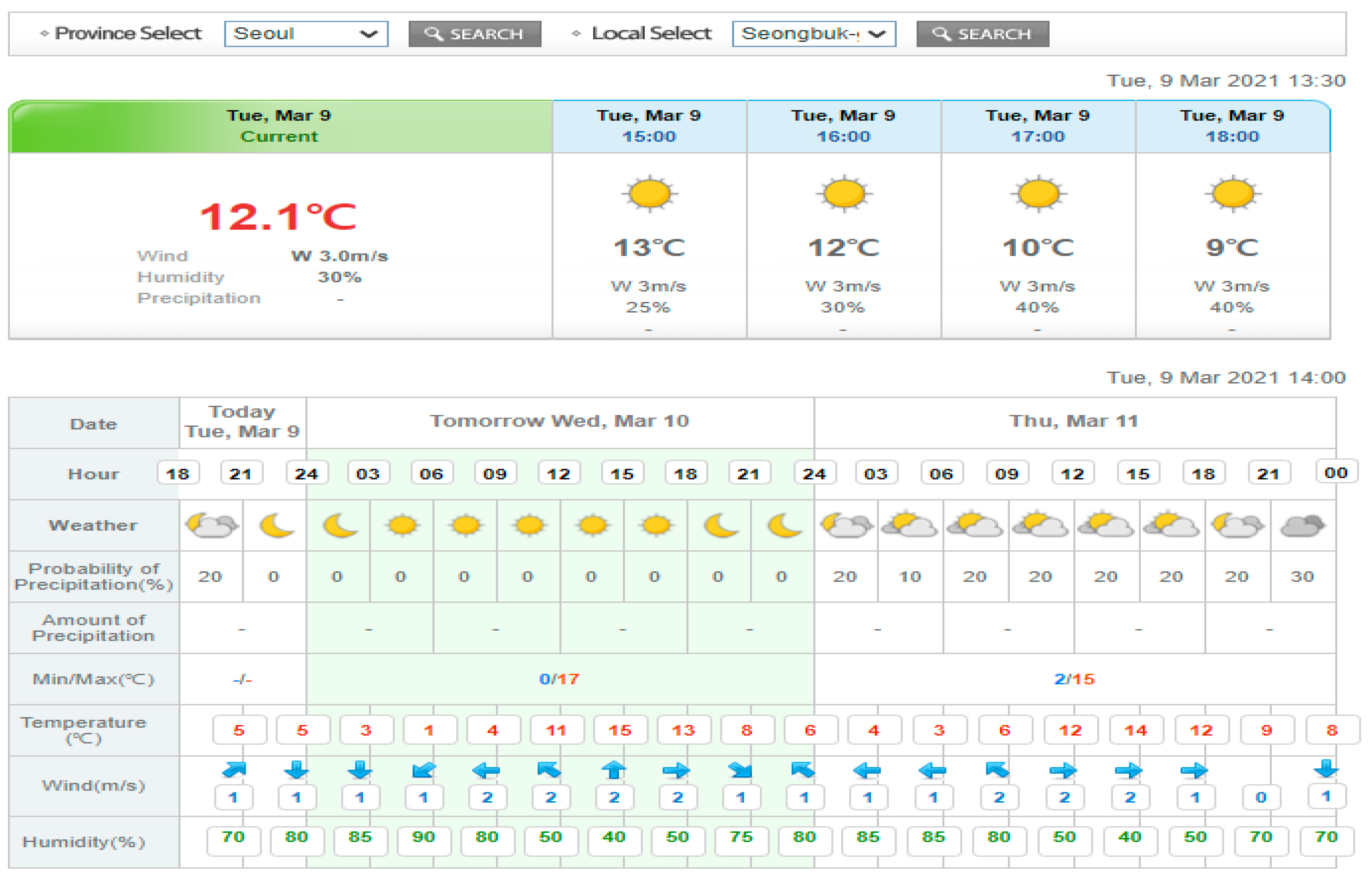


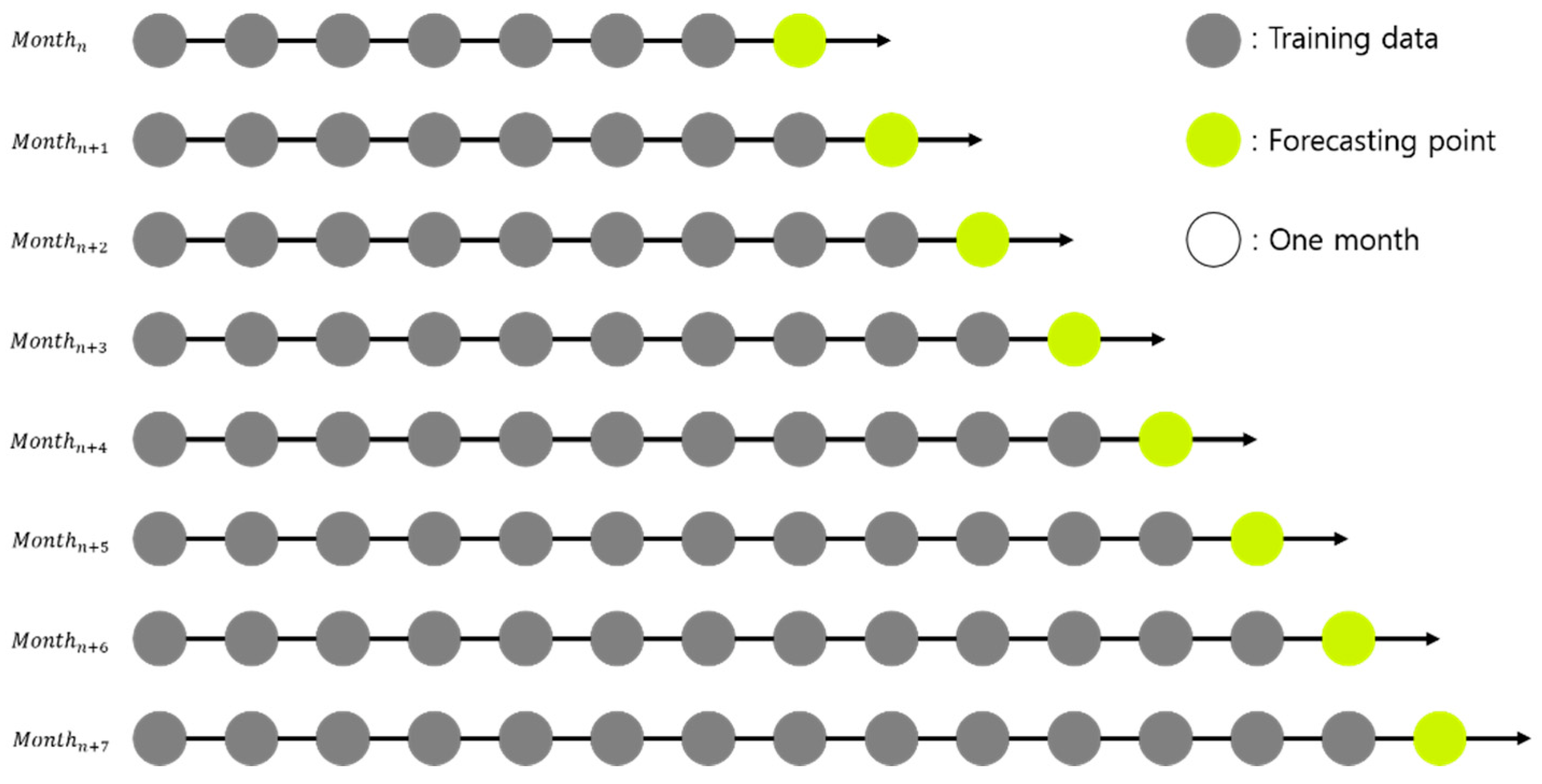







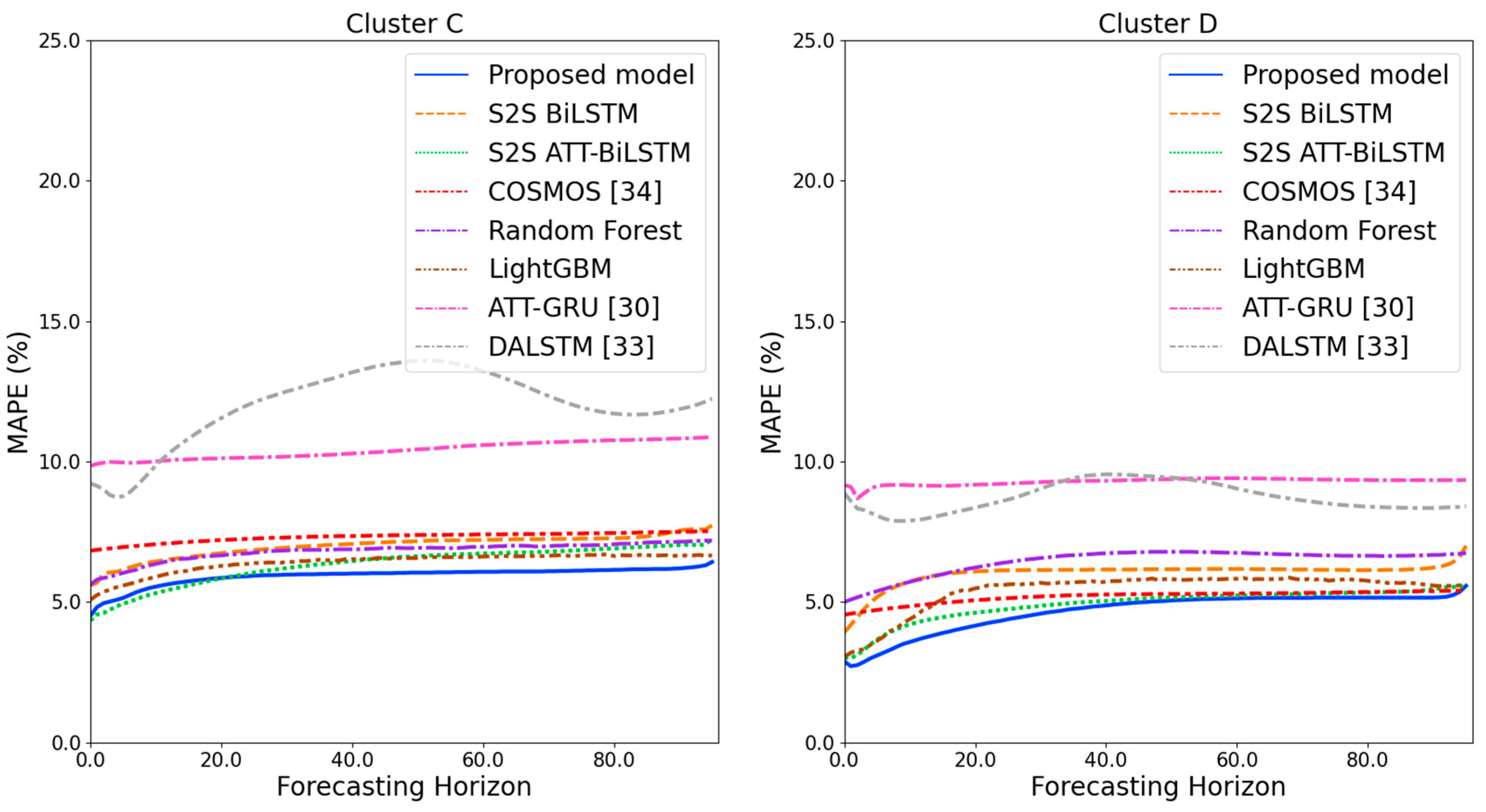
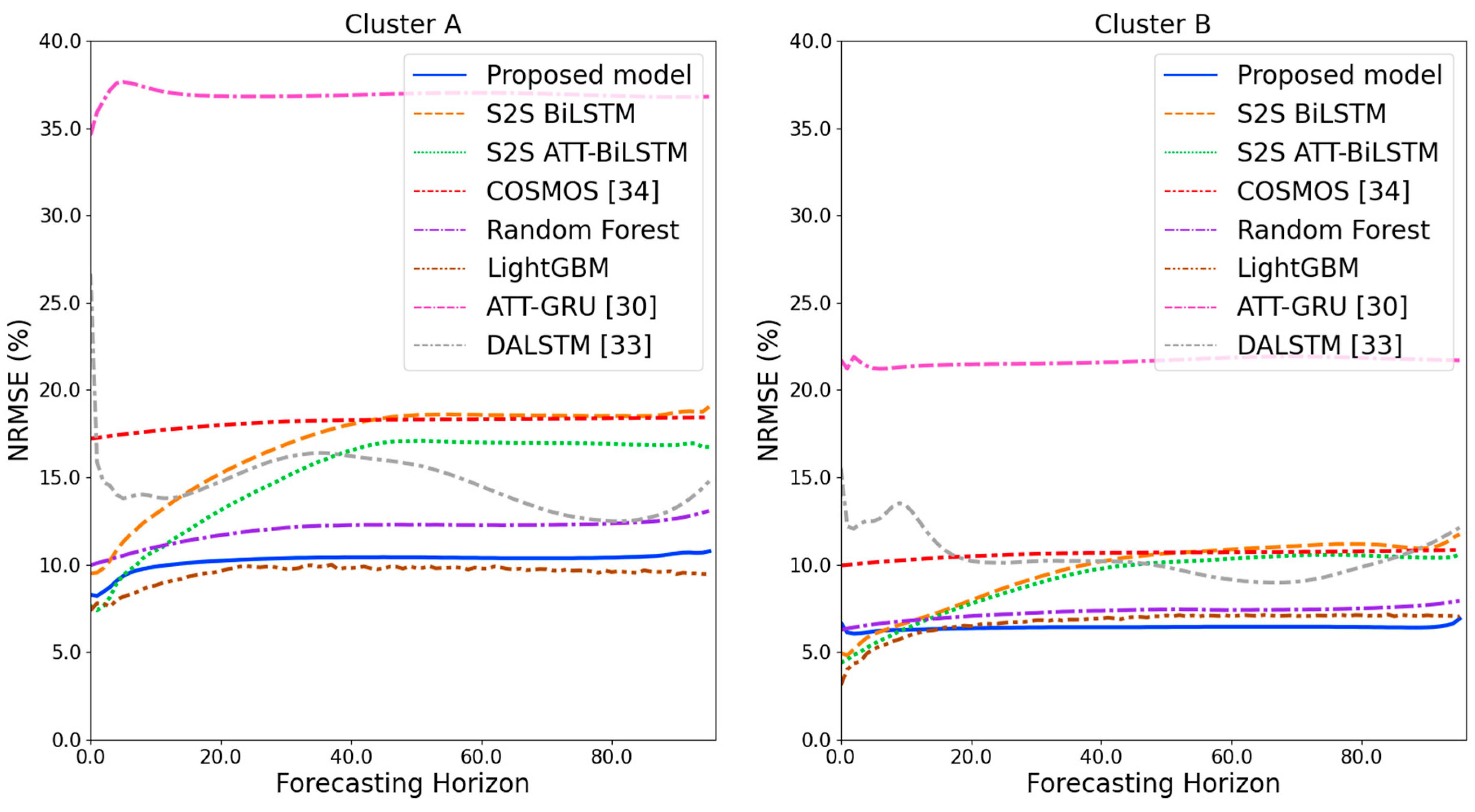
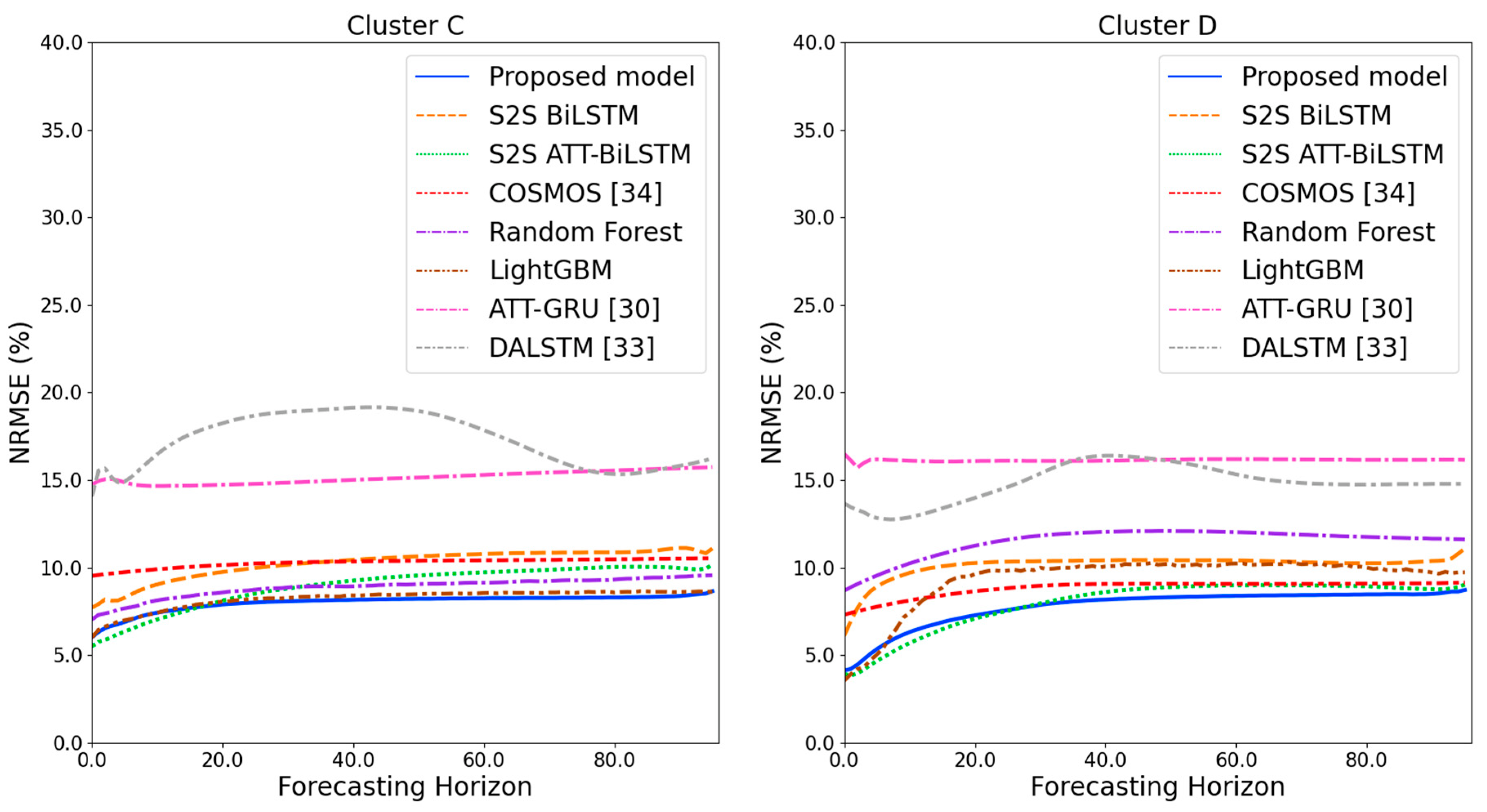
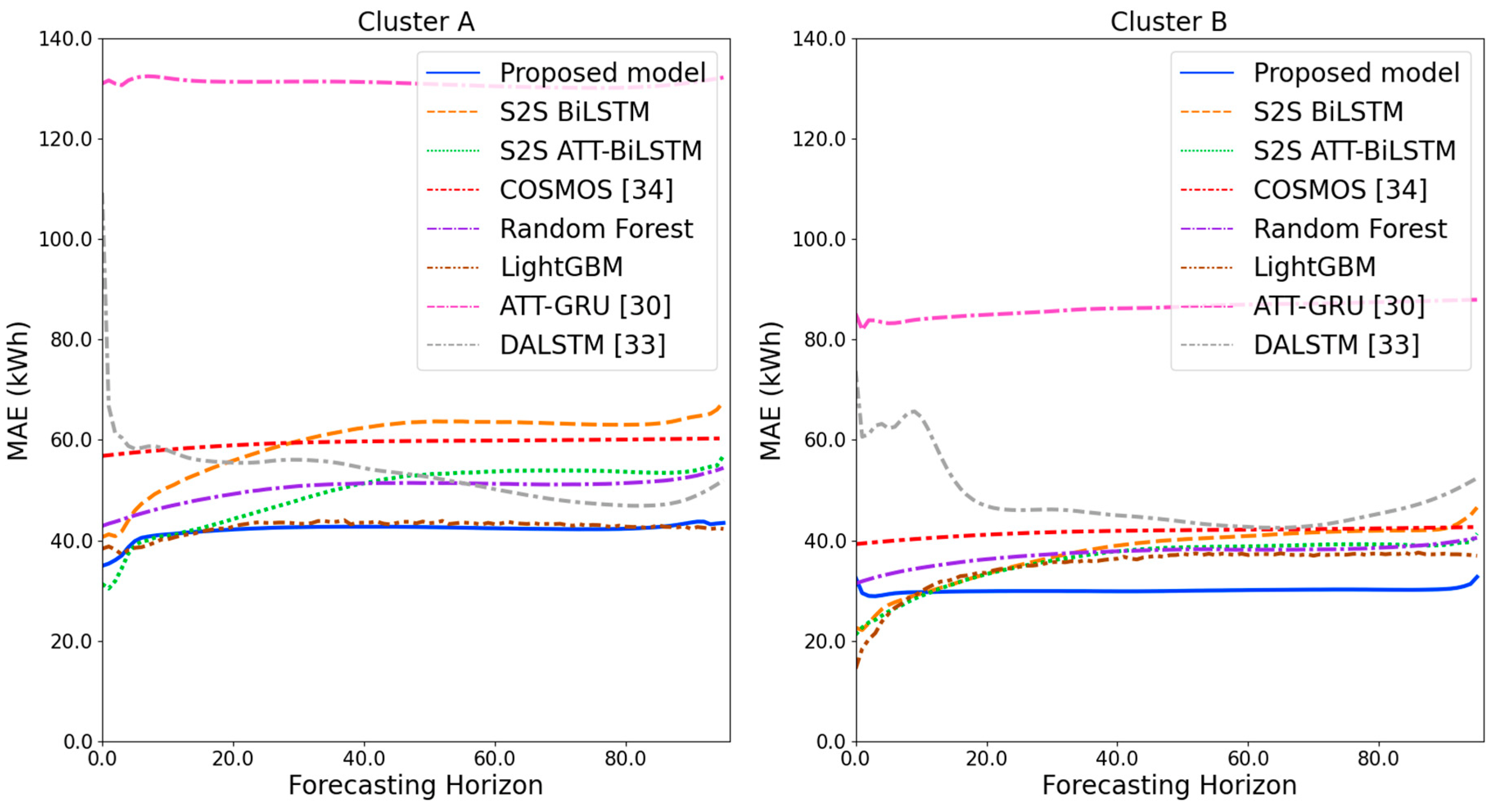
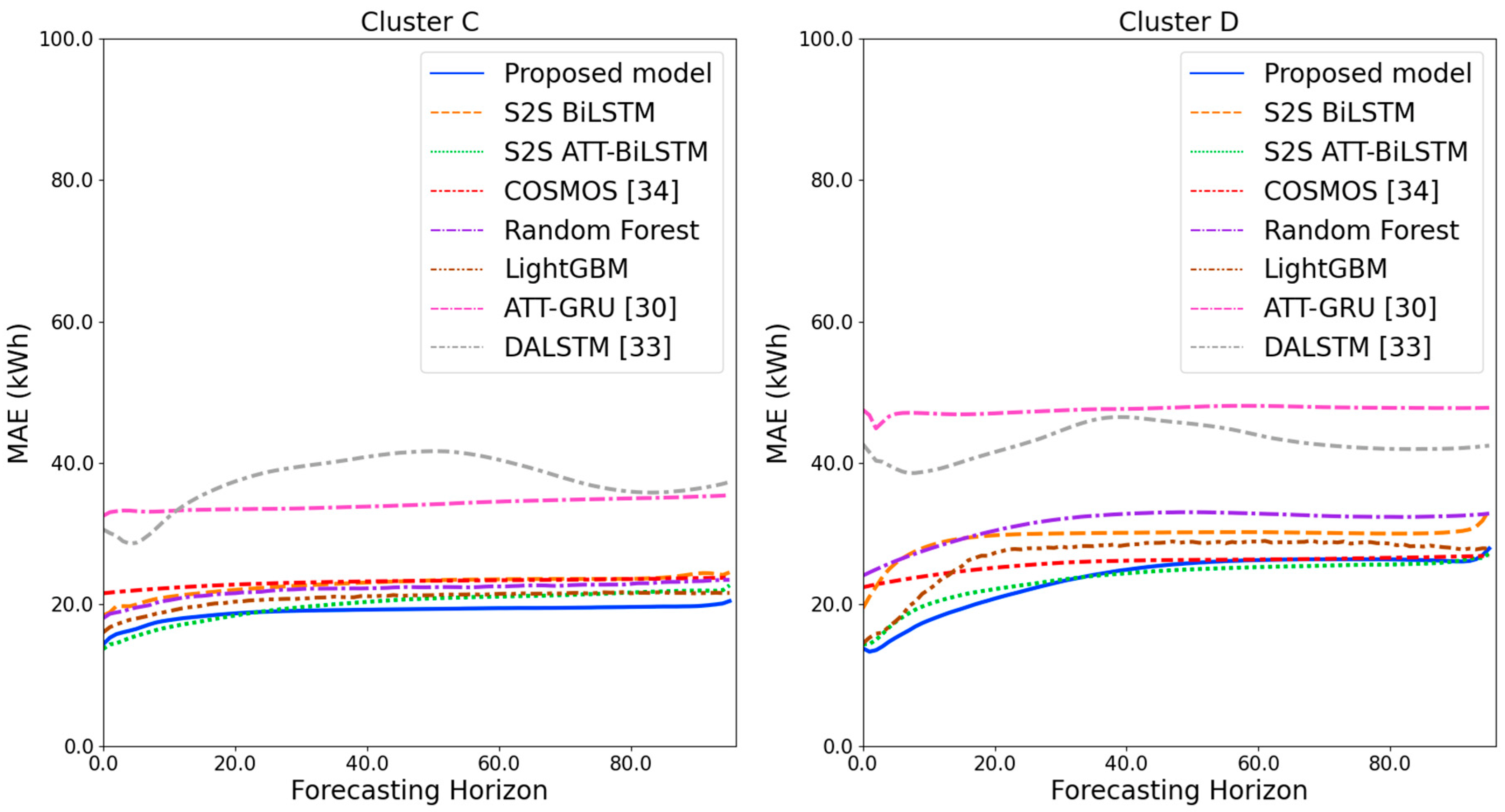
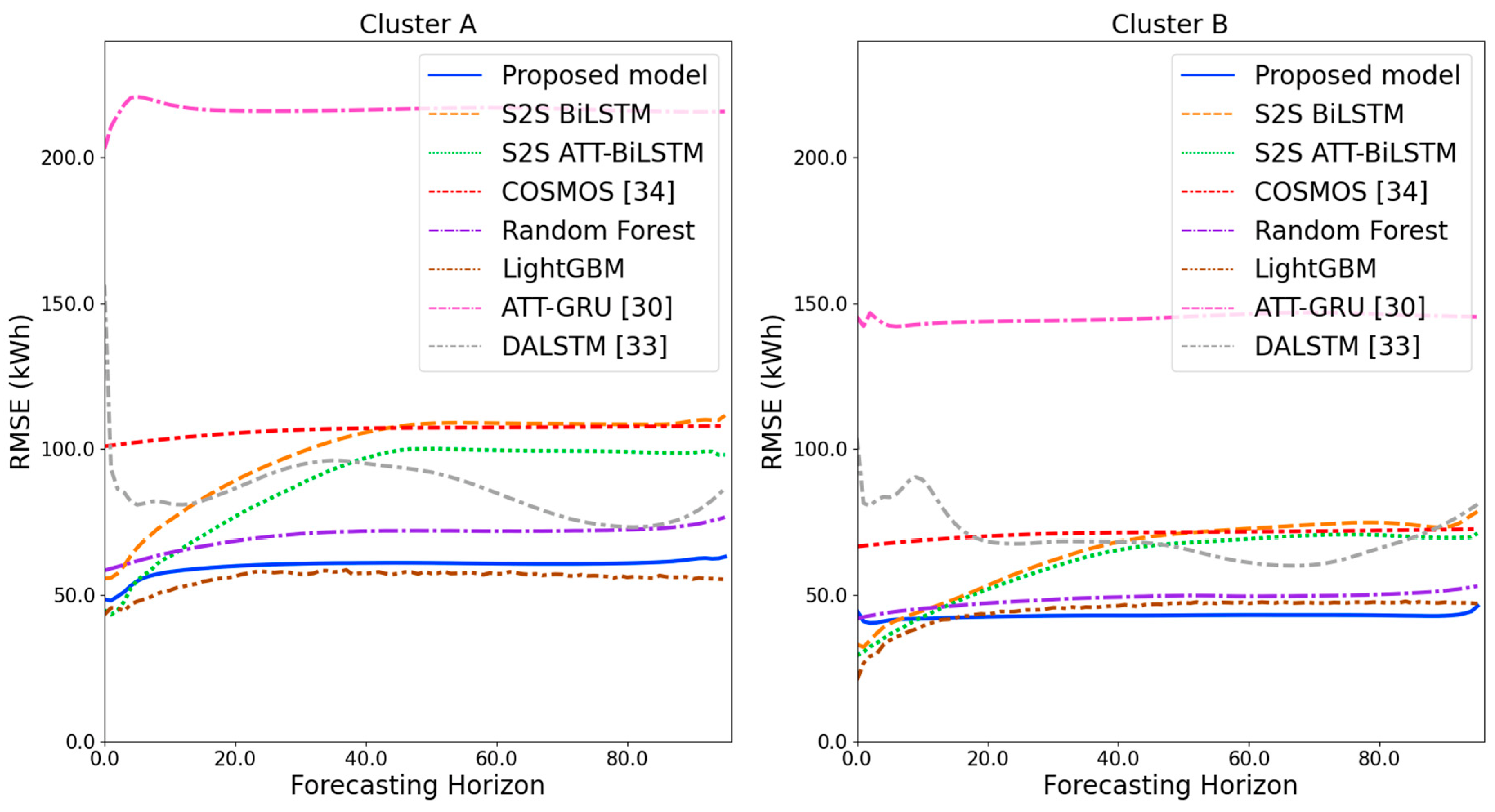

| Input Variable Identifier | Description (Type) | Input Variable Identifier | Description (Type) |
|---|---|---|---|
| No.01 | (numeric) | No.11 | (numeric) |
| No.02 | (numeric) | No.12 | (numeric) |
| No.03 | (numeric) | No.13 | (numeric) |
| No.04 | (numeric) | No.14 | (numeric) |
| No.05 | (numeric) | No.15 | (numeric) |
| No.06 | (binary) | No.16 | (numeric) |
| No.07 | (numeric) | No.17 | (numeric) |
| No.08 | (numeric) | No.18 | (numeric) |
| No.09 | (numeric) | No.19 | (numeric) |
| No.10 | (numeric) |
| Cluster A | Cluster B | Cluster C | Cluster D | |||||
|---|---|---|---|---|---|---|---|---|
| Training Set | Test Set | Training Set | Test Set | Training Set | Test Set | Training Set | Test Set | |
| Mean | 656.499 | 586.247 | 623.109 | 670.012 | 302.790 | 322.904 | 515.166 | 489.349 |
| Standard error | 0.954 | 1.418 | 0.587 | 0.929 | 0.205 | 0.323 | 0.35 | 0.515 |
| Median | 553.4 | 462.7 | 543.8 | 593.3 | 292.3 | 311.8 | 478.2 | 447.3 |
| Mode | 271.2 | 265.9 | 454.1 | 518.4 | 259.9 | 275.8 | 413.4 | 414.9 |
| Standard deviation | 357.686 | 333.674 | 220.187 | 218.575 | 76.902 | 76.172 | 119.92 | 121.328 |
| Sample variance | 127,939.5 | 111,338.3 | 48,482.45 | 47,775.23 | 5914.042 | 5802.298 | 14,380.87 | 14,720.47 |
| Kurtosis | −0.721 | −0.758 | 0.352 | 0.434 | 0.375 | 0.233 | −0.597 | −0.225 |
| Skewness | 0.676 | 0.736 | 1.076 | 1.096 | 0.689 | 0.716 | 0.673 | 0.871 |
| Range | 1529.7 | 1350.2 | 1104 | 1017.1 | 541.8 | 476.9 | 586.8 | 556.5 |
| Minimum | 195.4 | 181.4 | 296.2 | 383.2 | 114.1 | 130.7 | 300.6 | 292.5 |
| Maximum | 1725.1 | 1531.6 | 1400.2 | 1400.3 | 655.9 | 607.6 | 887.4 | 849 |
| Sum | 92,204,063 | 32,417,138 | 87,514,440 | 37,049,022 | 42,526,339 | 17,855,317 | 60,336,352 | 27,059,063 |
| Count | 140,448 | 55,296 | 140,448 | 55,296 | 140,448 | 55,296 | 117,120 | 55,296 |
| Model | Cluster A | Cluster B | Cluster C | Cluster D |
|---|---|---|---|---|
| LightGBM | Learning rate: | Learning rate: | Learning rate: | Learning rate: |
| 0.01, 0.05, 0.1 | 0.01, 0.05, 0.1 | 0.01, 0.05, 0.1 | 0.01, 0.05, 0.1 | |
| No. of iterations: 500, 1000 | No. of iterations: 500, 1000 | No. of iterations: 500, 1000 | No. of iterations: 500, 1000 | |
| No. of leaves: 64 | No. of leaves: 64 | No. of leaves: 64 | No. of leaves: 64 | |
| Subsample: 0.5, 1.0 | Subsample: 0.5, 1.0 | Subsample: 0.5, 1.0 | Subsample: 0.5, 1.0 | |
| XGBoost | Learning rate: 0.01, 0.05, 0.1 | Learning rate: 0.01, 0.05, 0.1 | Learning rate: 0.01, 0.05, 0.1 | Learning rate: 0.01, 0.05, 0.1 |
| No. of iterations: 500, 1000 | No. of iterations: 500, 1000 | No. of iterations: 500, 1000 | No. of iterations: 500, 1000 | |
| Subsample: 0.5, 1.0 | Subsample: 0.5, 1.0 | Subsample: 0.5, 1.0 | Subsample: 0.5, 1.0 | |
| Colsample by tree: | Colsample by tree: | Colsample by tree: | Colsample by tree: | |
| 0.5, 1.0 | 0.5, 1.0 | 0.5, 1.0 | 0.5, 1.0 | |
| NGBoost | No. of iterations: 500, 1000, 1500 | No. of iterations: 500, 1000, 1500 | No. of iterations: 500, 1000, 1500 | No. of iterations: 500, 1000, 1500 |
| Random Forest | No. of trees: 64, 128 | No. of trees: 64, 128 | No. of trees: 64, 128 | No. of trees: 64, 128 |
| Random state: 32, 64 | Random state: 32, 64 | Random state: 32, 64 | Random state: 32, 64 | |
| MLP | No. of layers: 4, 5, 6, 7 | No. of layers: 4, 5, 6, 7 | No. of layers: 4, 5, 6, 7 | No. of layers: 4, 5, 6, 7 |
| Activation function: ReLU | Activation function: ReLU | Activation function: ReLU | Activation function: ReLU | |
| Optimizer: Adam | Optimizer: Adam | Optimizer: Adam | Optimizer: Adam | |
| Learning rate: 0.001 | Learning rate: 0.001 | Learning rate: 0.001 | Learning rate: 0.001 |
| Evaluation Metric | Model | Cluster A | Cluster B | Cluster C | Cluster D |
|---|---|---|---|---|---|
| MAPE (%) | LightGBM | 7.01 | 4.74 | 6.98 | 4.98 |
| MLP | 12.06 | 7.03 | 7.61 | 5.67 | |
| RF | 7.53 | 4.98 | 7.24 | 5.38 | |
| XGBoost | 7.22 | 5.12 | 7.52 | 5.29 | |
| NGBoost | 9.64 | 5.44 | 7.73 | 5.90 | |
| MAE (kWh) | LightGBM | 40.71 | 32.00 | 22.18 | 23.47 |
| MLP | 68.59 | 45.95 | 23.10 | 27.30 | |
| RF | 43.81 | 34.09 | 23.46 | 25.49 | |
| XGBoost | 41.81 | 32.81 | 24.76 | 24.81 | |
| NGBoost | 54.25 | 37.04 | 24.85 | 29.21 | |
| RMSE (kWh) | LightGBM | 61.31 | 49.01 | 30.81 | 36.26 |
| MLP | 119.07 | 75.39 | 32.5 | 41.11 | |
| RF | 67.2 | 54.73 | 32.89 | 40.51 | |
| XGBoost | 63.58 | 48.34 | 34.39 | 37.16 | |
| NGBoost | 82.05 | 59.1 | 34.43 | 44.17 | |
| NRMSE (%) | LightGBM | 9.37 | 7.63 | 9.78 | 7.25 |
| MLP | 18.91 | 11.74 | 10.32 | 8.22 | |
| RF | 10.67 | 8.52 | 10.45 | 8.10 | |
| XGBoost | 10.09 | 7.53 | 10.92 | 7.43 | |
| NGBoost | 13.03 | 9.21 | 10.93 | 8.83 |
| Cluster A | Cluster B | Cluster C | Cluster D |
|---|---|---|---|
| 0.984 | 0.978 | 0.923 | 0.957 |
| Model | Package | Selected Hyperparameters |
|---|---|---|
| LightGBM | LightGBM Scikit-learn | Learning rate: 0.05 |
| No. of iterations: 1000 | ||
| No. of leaves: 32 | ||
| Subsample: 0.5 | ||
| Random Forest | Scikit-learn | No. of trees: 128 |
| Random state: 64 | ||
| S2S BiLSTM | Pytorch | No. of hidden nodes: 15 |
| No. of hidden layers: 2 | ||
| Activation function: ReLU | ||
| Optimizer: Adam | ||
| Learning rate: 0.001 | ||
| No. of epochs: 350 | ||
| S2S ATT-BiLSTM | Pytorch | No. of hidden nodes: 15 |
| No. of hidden layers: 2 | ||
| Activation function: ReLU | ||
| Optimizer: Adam | ||
| Learning rate: 0.001 | ||
| No. of epochs: 350 | ||
| ATT-GRU [30] | Pytorch | No. of hidden nodes: 15 |
| No. of hidden layers: 2 | ||
| Activation function: SELU | ||
| Optimizer: Adam | ||
| Learning rate: 0.001 | ||
| No. of epochs: 150 | ||
| DALSTM [33] Stage 1: LSTM Stage 2: DARNN | Pytorch | LSTM |
| No. of hidden nodes: 15 | ||
| No. of hidden layers: 2 | ||
| Activation function: ReLU | ||
| Optimizer: Adam | ||
| Learning rate: 0.001 | ||
| No. of epochs: 350 | ||
| DARNN | ||
| No. of hidden nodes: 64 | ||
| Time steps: 96 | ||
| Optimizer: Adam | ||
| Learning rate: 0.001 | ||
| No. of epochs: 150 | ||
| COSMOS [34] Stage 1: MLP Stage 2: PCR | Scikit-learn | MLP |
| No. of hidden nodes: 15 | ||
| No. of hidden layers: 4, 5, 6, 7 | ||
| Activation function: ReLU | ||
| Optimizer: Adam | ||
| Learning rate: 0.001 | ||
| No. of epochs: 150 | ||
| PCR | ||
| Principal components: 1 | ||
| Sliding window size: 672 |
Publisher’s Note: MDPI stays neutral with regard to jurisdictional claims in published maps and institutional affiliations. |
© 2021 by the authors. Licensee MDPI, Basel, Switzerland. This article is an open access article distributed under the terms and conditions of the Creative Commons Attribution (CC BY) license (https://creativecommons.org/licenses/by/4.0/).
Share and Cite
Park, J.; Hwang, E. A Two-Stage Multistep-Ahead Electricity Load Forecasting Scheme Based on LightGBM and Attention-BiLSTM. Sensors 2021, 21, 7697. https://doi.org/10.3390/s21227697
Park J, Hwang E. A Two-Stage Multistep-Ahead Electricity Load Forecasting Scheme Based on LightGBM and Attention-BiLSTM. Sensors. 2021; 21(22):7697. https://doi.org/10.3390/s21227697
Chicago/Turabian StylePark, Jinwoong, and Eenjun Hwang. 2021. "A Two-Stage Multistep-Ahead Electricity Load Forecasting Scheme Based on LightGBM and Attention-BiLSTM" Sensors 21, no. 22: 7697. https://doi.org/10.3390/s21227697
APA StylePark, J., & Hwang, E. (2021). A Two-Stage Multistep-Ahead Electricity Load Forecasting Scheme Based on LightGBM and Attention-BiLSTM. Sensors, 21(22), 7697. https://doi.org/10.3390/s21227697







